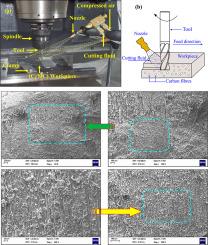使用自主研发的纳米绿色切削液加工 Cf/SiC 复合材料:加工表面纤维形态
IF 6.1
1区 工程技术
Q1 ENGINEERING, MANUFACTURING
引用次数: 0
摘要
碳纤维增强碳化硅(Cf/Sic)复合材料广泛应用于汽车、航空航天等不同行业。Cf/SiC 是本地开发的,并介绍了制造过程的细节。纳米流体,即石墨烯氧化物有机硼(GOOB)是本地开发的切削液。这种纳米流体以不同比例混合在绿色切削液(GCF)中,并对浓度进行了优化。纳米流体的特征通过先进技术进行确认。为了降低 Cf/SiC 制品的表面粗糙度,在不同的加工环境下进行了端铣操作,如干燥、使用切削液和纳米流体的泛滥冷却以及使用纳米流体的最小量切削液。通过改变不同的输入参数(即切削速度、进给量和切削深度)来进行加工操作。结果表明,使用 0.5 % GOOB 和 GCF 时,表面粗糙度最小为 1.845 μm。这项工作将有助于研究人员探索用于加工 Cf/SiC 基陶瓷基复合材料的本地开发的纳米绿色切削液的制备和相互作用机理。本文章由计算机程序翻译,如有差异,请以英文原文为准。

Machining of Cf/SiC composite with indigenously developed nano green cutting fluid: Machined surface fibre morphology
The Carbon fibre reinforced Silicon Carbide (Cf/Sic) composites are widely used in different industries such as automotive, aerospace, etc. The Cf/SiC is indigenous developed and detail of the fabrication procedure is presented. The nano fluid, namely Graphene Oxide Organo Boron (GOOB) is developed indigenously for using as the cutting fluid. This nano fluid is mixed in green cutting fluid (GCF) in different proportions and the concentration is optimized. The nano fluid is characterized by advanced techniques for the confirmation. To reduce the surface roughness on the fabricated Cf/SiC, end milling operation is carried out with different machining environments such as dry, flood cooling with cutting fluid and nano fluid and minimum quantity cutting fluid with nano fluid. The machining operations are carried out by varying different input parameters, namely, cutting speed, feed rate, and depth of cut. The results indicated that the minimum surface roughness of 1.845 μm is obtained when 0.5 % GOOB with GCF is used. This work would benefit the researchers exploring the preparation and interaction mechanism of the indigenously developed nano green cutting fluid for machining Cf/SiC-based ceramic matrix composites.
求助全文
通过发布文献求助,成功后即可免费获取论文全文。
去求助
来源期刊

Journal of Manufacturing Processes
ENGINEERING, MANUFACTURING-
CiteScore
10.20
自引率
11.30%
发文量
833
审稿时长
50 days
期刊介绍:
The aim of the Journal of Manufacturing Processes (JMP) is to exchange current and future directions of manufacturing processes research, development and implementation, and to publish archival scholarly literature with a view to advancing state-of-the-art manufacturing processes and encouraging innovation for developing new and efficient processes. The journal will also publish from other research communities for rapid communication of innovative new concepts. Special-topic issues on emerging technologies and invited papers will also be published.
 求助内容:
求助内容: 应助结果提醒方式:
应助结果提醒方式:


